GARDENS BY THE BAY
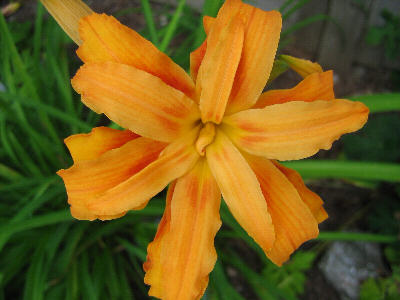
ORANGE PERENNIALS & THEIR COMPANIONS
The revered British garden writer, Christopher Lloyd, devotes nearly 20 pages of his 2001 book, Color for Adventurous Gardeners, to the colour orange. He begins by saying "Of all colours, orange is the one that cries out the loudest for contrast."
You can find many wonderful perennials with orange-toned blooms below, alongside plant partners, both complementary and contrasting, that garden writers tell us about.
* Watch for the animated hummingbird and butterfly with the plants that attract them. *
The deer icon indicates plants that deer are not usually attracted to.
   The best time and method to propagate plants can be found on our image-intensive PROPAGATION page.
To help your plants grow their best, check out our FERTILIZATION page.
To create your own plant partnerships based on tried and true color theory, check out our GARDEN COLOR page.
To see if a particular plant is on this page press Ctrl+F, type in the name, then click the Find button.
The best time and method to propagate plants can be found on our image-intensive PROPAGATION page.
To help your plants grow their best, check out our FERTILIZATION page.
To create your own plant partnerships based on tried and true color theory, check out our GARDEN COLOR page.
To see if a particular plant is on this page press Ctrl+F, type in the name, then click the Find button.
ACHILLEA
 For those accustomed to the cream, yellow, pink and red Yarrows, the form below is a welcome addition in the orange range. In fact, its name describes the shade perfectly.
Achillea millefolium 'Terra Cotta': 2-1/2 to 3' tall x 2 to 2-1/2'
For those accustomed to the cream, yellow, pink and red Yarrows, the form below is a welcome addition in the orange range. In fact, its name describes the shade perfectly.
Achillea millefolium 'Terra Cotta': 2-1/2 to 3' tall x 2 to 2-1/2'
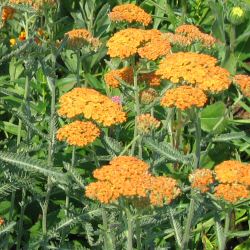
synonym: Achillea x 'Terra Cotta'
what: Achillea taygetea x Achillea millefolium
colour: peachy-yellow, maturing to coppery bronze
wonderful near: blue plants
in front of: dark-foliaged plants
spectacular with: Nepeta 'Souvenir de André Chaudron' & Caryopteris 'Worcester Gold'
Many colour choices in many sizes can be seen by visiting the links below. Partnership ideas abound.
pink Yarrow
red Yarrow
silver foliage Yarrow
white Yarrow
yellow Yarrow
ALCEA
 If you favour the blowsy double flowers among this group, here is yet another showy form in the orangey family of colours.
Alcea rosea 'Chater's Double Apricot': apricot double-flowered
Are you having trouble with your Hollyhocks? Information at the links below may help explain why and provide suggestions on how to grow them well.
pink Hollyhocks
red Hollyhocks
white Hollyhocks
yellow Hollyhocks
Hollyhocks to attract Hummingbirds
If you favour the blowsy double flowers among this group, here is yet another showy form in the orangey family of colours.
Alcea rosea 'Chater's Double Apricot': apricot double-flowered
Are you having trouble with your Hollyhocks? Information at the links below may help explain why and provide suggestions on how to grow them well.
pink Hollyhocks
red Hollyhocks
white Hollyhocks
yellow Hollyhocks
Hollyhocks to attract Hummingbirds
ASCLEPIAS
  Although available in several colours, the Butterfly Weeds usually bring the colour orange immediately to mind, none more so than the forms below.
Asclepias tuberosa: Butterfly Weed
Although available in several colours, the Butterfly Weeds usually bring the colour orange immediately to mind, none more so than the forms below.
Asclepias tuberosa: Butterfly Weed
generally with: deep purple or blue flowers such as Lavandula
with: Ornamental Grasses, Sedum
between: Nepeta x faassenii & Euphorbia epithymoides
with: Achillea 'Moonshine', Buddleia x weyeriana 'Sungold', Gaillardia, Heliopsis helianthoides
with: Platycodon grandiflorus var. Mariesii Blue, Verbena canadensis, Veronica, Veronica longifolia 'Icicle',
Veronica spicata 'Red Fox'
combined with: Echinacea purpurea, Rudbeckia & Solidago
Asclepias tuberosa 'Gay Butterflies': orange shades
with: hot-coloured border perennials
with: deep blues such as Veronica, Delphinium
For help and suggestions about this perennial, check the links below.
numerous Butterfly Weed forms
white Butterfly Weed
BELAMCANDA
Blackberry Lily, named after its jet-black seeds, has wonderful bright orange flowers, similar to many cultivars of
x Pardancanda norrisii (see image below) of which it a parent.
Belamcanda chinensis: Blackberry Lily; orange, 35-47" tall x 18-23" spread, sword-shaped leaves, spotted flowers
for contrast with: large-flowered plants
for contrast with: tall, deep purple perennials
with: fine-textured plants such as Gypsophila paniculata, Hemerocallis
with: same companions as x Pardancanda norrisii (see farther down on this page)
BUDDLEIA
 
 We have all known and loved the various coloured forms of the Butterfly Bushes. Now it can also be admired in the yellow-orange shade of the cultivar below.
Buddleia x weyeriana 'Sungold': yellow-orange
We have all known and loved the various coloured forms of the Butterfly Bushes. Now it can also be admired in the yellow-orange shade of the cultivar below.
Buddleia x weyeriana 'Sungold': yellow-orange
with: Asclepias tuberosa, Crocosmia (Montbretia), Rudbeckia hirta, Coreopsis spp.
If you are not growing forms in this genus yet, do so soon. Find out which ones may suit your site and how to deal with them once planted at the links below.
numerous Butterfly Bush forms
Butterfly Bushes to attact Hummingbirds
CHEIRANTHUS
The English Wallflower is not seen often enough in our North American gardens, perhaps because this is a biennial plant. It is, however, definitely worth a try.
Cheiranthus: Wallflower
behind: Muscari, Narcissus (short, pale yellow with orange cup)
with: Scilla campanulata, Nepeta
mass planted with: bulbs
in front of: Intermediate yellow or purple Iris, Darwin Tulipa
Cheiranthus allionii: Siberian Wallflower
mass planted with: Tulipa
COREOPSIS
 Most Tickseeds are in the yellow colour range. The edging form below, however, is an orangey-yellow shade that cries out for dark purple co-bloomers nearby.
Coreopsis auriculata 'Nana': Mouse-Ear Coreopsis, orange-yellow Tickseed; dwarf (6-9")
Most Tickseeds are in the yellow colour range. The edging form below, however, is an orangey-yellow shade that cries out for dark purple co-bloomers nearby.
Coreopsis auriculata 'Nana': Mouse-Ear Coreopsis, orange-yellow Tickseed; dwarf (6-9")
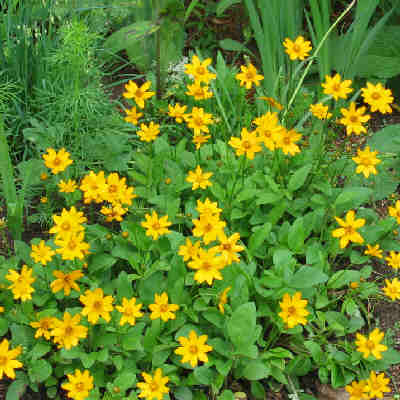
a vibrant combination with: blue Geranium magnificum
with: Salvia x sylvestris 'May Night'
For a long bloom season, nothing can beat the Tickseeds which will nearly bloom themselves to death. Check out the many forms from which to choose at the links below and learn about their care and feeding requirements as well.
Coreopsis for edging
pink Coreopsis
yellow Coreopsis
CROCOSMIA
I'm new to this genus, having picked up my first at a plant sale in 2003. For some reason I was surprised when it survived its first winter. Now I'm anxiously awaiting the appearance of its strap-shaped foliage this year as well.
Crocosmia: Montbretia; bright orange
with: Coreopsis verticillata
Crocosmia 'Emily McKenzie':
combined with: Elymus canadensis (blue lyme grass) & Artemisia 'Powis Castle'
These should be grown more often. If you have the conditions they require for best performance, you will want to try the form above or the one you will find at the link below.
yellow Montbretia
GEUM
 I wouldn't want to be without either of the two forms of Avens grown in my garden. 'Mrs. Bradshaw' on the other hand has been banished as she does not appreciate our cold Canadian winters.
Geum borisii: Avens
I wouldn't want to be without either of the two forms of Avens grown in my garden. 'Mrs. Bradshaw' on the other hand has been banished as she does not appreciate our cold Canadian winters.
Geum borisii: Avens
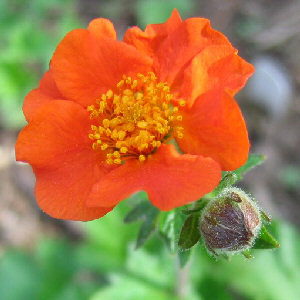
now called: Geum coccineum (see below)
never plant near: pink perennials (the clash will be terrible)
Geum 'Juliana':

note the difference in colour between this cultivar and the species above; this one blooms later and lighter
Geum coccineum: Avens
for a profile of this plant, follow the link to Geum - Profile
formerly: Geum borisii
with: Narcissus poeticus recurvatus
Geum quellyon 'Mrs. Bradshaw': orange-red double
synonym: Geum chiloense 'Mrs. Bradshaw'
generally with: dark blue or purple flowers
with: other bright flowers such as Rudbeckia hirta, Coreopsis
with: Brunnera, Myosotis, Rudbeckia hirta, Coreopsis
If your Avens isn't growing well, the link below may help you may find out why.
yellow Geum
HELENIUM
 Much more attractive than one of its common names suggests, Sneezeweed - also known as Helen's Flower - is a showy late-summer beauty. Given a site in full sun with evenly moist, humus-rich soil they will reward you handsomely with their abundant daisy-like blooms. These spectacular plants will draw the eye to their rear border position. Staking may be required to keep them upright, although pinching their stems once or twice in spring will promote more compact growth.
Helenium autumnale 'Brilliant': orange-bronze, 3'
Much more attractive than one of its common names suggests, Sneezeweed - also known as Helen's Flower - is a showy late-summer beauty. Given a site in full sun with evenly moist, humus-rich soil they will reward you handsomely with their abundant daisy-like blooms. These spectacular plants will draw the eye to their rear border position. Staking may be required to keep them upright, although pinching their stems once or twice in spring will promote more compact growth.
Helenium autumnale 'Brilliant': orange-bronze, 3'

combined with: Veronicastrum virginicum & Sedum 'Autumn Joy'
Helenium 'Hoopesii': Orange Helenium; 2-3' tall
synonym: Helenium hoopesii
with: Achillea, Salvia, Sedum
More choices, partners and information can be found at the link below.
yellow Helenium
HEMEROCALLIS
 Popular everywhere, and available in a multitude of colours and shades as well as heights, Daylilies continue to delight us all. Whether planted alone in masses or combined with other bulbs, perennials, ornamental grasses, shrubs and vines, their showy "beautiful for a day" flowers keep right on coming. Keep them dead-headed and cut stalks back to below the foliage to maintain a tidy appearance throughout their long bloom period.
Some of the daylilies below are Spider and Unusual Form Daylilies. Follow the link to learn more about the beautiful cultivars available in these two classes and see images that show their amazing appearance. You will also discover how to find suppliers of these classes in your area.
Hemerocallis: Daylily, orange shades
Popular everywhere, and available in a multitude of colours and shades as well as heights, Daylilies continue to delight us all. Whether planted alone in masses or combined with other bulbs, perennials, ornamental grasses, shrubs and vines, their showy "beautiful for a day" flowers keep right on coming. Keep them dead-headed and cut stalks back to below the foliage to maintain a tidy appearance throughout their long bloom period.
Some of the daylilies below are Spider and Unusual Form Daylilies. Follow the link to learn more about the beautiful cultivars available in these two classes and see images that show their amazing appearance. You will also discover how to find suppliers of these classes in your area.
Hemerocallis: Daylily, orange shades
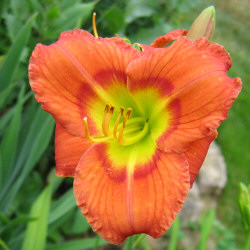
in front of: Narcissus & Tulipa (to hide their dying foliage)
in front of: Veronica spp., esp. 'Sunny Border Blue'
with: late-blooming true bulbous Lilium, tall blue Aconitum, Astilbe, Iris sibirica, Lythrum
with: Hosta, Ferns, Gloriosa Daisies, Rudbeckia, tall Verbascum, Heliopsis
Hemerocallis: late-blooming orange
with: Artemisia lactiflora 'Guizho'
Hemerocallis: light orange
in front of: Phlox paniculata (white) & Aconitum (violet or blue & white)
Hemerocallis 'Green Kwanso': or other double orange

sometimes sold incorrectly as: 'Apricot Beauty' - there is no registered daylily by that name
this cultivar can be seen in the border around this page and in the images at the top of the page and directly above
with: the beautiful but invasive Ladybells - Adenophora confusa
Hemerocallis 'Jan's Twister': peach self with green throat, scape height 28", bloom 11.5", Rebloomer
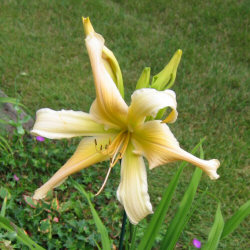
this Unusual Form Crispate cultivar was registered in 1991, bloom season EM
Hemerocallis 'Octopus Hugs': reddish-orange bitone above yellow throat, bloom season E, Fragrant, Rebloomer
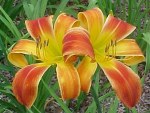
this Unusual Form Cascade daylily cultivar was registered in 2000, height 38", bloom 8"
to see more Unusual Form daylilies, visit the Strongs' Daylilies site
Hemerocallis 'On Silken Thread': medium orange, burnt orange eye & edge above green throat, bloom season M
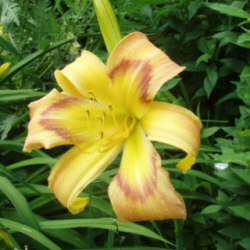
this Unusual Form Crispate cultivar was registered in 1998 and has a 36" scape height & bloom 9"
Hemerocallis 'Painted Lady': light orange, 36" tall
combined with: Lilium 'Golden Splendor', Echinops ritro & Lythrum 'Dropmore Purple'
Hemerocallis 'Sparks': brilliant red-orange
combined with: brick & gold Hemerocallis 'Bright Banner', rich red Hemerocallis 'Shining Plumage' &
beside: shorter forms of Achillea
Hemerocallis 'Tiny Pumpkin':
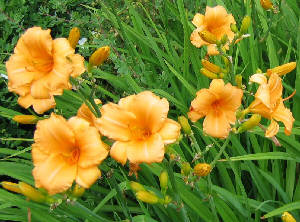
another small-flowered cultivar, this orange daylily has a colour that blends with everything nearby
orange echo with: Papaver rupifragum
Oh, what a show can be arranged by adding drifts of different daylilies to your garden! Perfect choices with the perfect partners can be found by following our links below.
a multitude of Daylily choices
pink Daylilies
purple Daylilies
red Daylilies
Spider and Unusual Form Daylilies
white Daylilies
yellow Daylilies
IRIS
 In the genus, Iris, there is surely something for everyone. Named in honour of a mythological Greek goddess who rode to earth on a rainbow, fittingly this plant comes in every colour imaginable and in forms that can be grown under a variety of conditions and exposures.
Iris x germanica: Bearded Iris, orange shades
In the genus, Iris, there is surely something for everyone. Named in honour of a mythological Greek goddess who rode to earth on a rainbow, fittingly this plant comes in every colour imaginable and in forms that can be grown under a variety of conditions and exposures.
Iris x germanica: Bearded Iris, orange shades
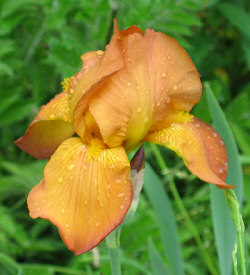
with: Phlox subulata (lavender-blue) & Dicentra spectabilis (white)
Of course there are many more Irises available than those that appear on our site, but following the links below will give you some suggestions on where to start if you wish to add more to your beds.
blue Iris
bulbous Iris
Iris for edging
purple Iris
red Iris
white Iris
yellow Iris
Iris with variegated foliage
KNIPHOFIA
The Torch Lily, also known as Red-Hot Poker, bears spikes of tubular flowers above narrow, stiff foliage. Planted in full sun and well-drained soil, they are best left undisturbed to spread wide and produce the bright, bold, vertical accents we all admire.
Kniphofia: Red Hot Poker, Torchlily
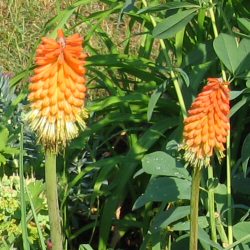
with: Coreopsis lanceolata 'Goldfink', Helenium autumnale, Hemerocallis, Rudbeckia, Lysimachia punctata
behind: Achillea 'Moonshine'
Kniphofia x pfitzeri: deep orange
with: Gypsophila paniculata, Phlox paniculata, Boltonia asteroides, Nepeta x faassenii
Kniphofia 'Royal Castle Hybrids': Red Hot Poker, 31" x 24-28"
note: various combinations of red, yellow and orange; heads often bicoloured
behind: Salvia officinalis 'Icterina'
beside: Lavatera 'Mont Blanc', Sedum 'Autumn Joy'
in front of: Echinops 'Taplow Blue'
Kniphofia uvaria: Common Torch Lily
Follow the link below for more choices and partnership ideas.
yellow Torch Lily
LILIUM
Available in many sizes, colours and forms, Lilies are prized wherever they are grown. Growing from bulbs, they produce a tall stalk on which their flowers appear in terminal clusters. With colours vibrant or subtle, pure or spotted or streaked, all have 3 petals and 3 petal-like sepals and add an element of grace to our gardens wherever they are planted.
Lilium: Lily, various orange shades
to contrast with: Eryngium planum (12-18"; steely blue)
Lilium: warm orange
with: Aconitum x bicolor 'Bicolor' (blue & white)
Lilium: Asiatic Lily, orange
behind: Veronica longifolia, Veronica 'Sunny Border Blue', 'Goodness Grows' or 'Romily Purple'
Lilium 'Matrix': vibrant orange

this one is so hot it sizzles, a perfect companion for blues or purples
 Lilium tigrinum: Tiger Lily
Lilium tigrinum: Tiger Lily
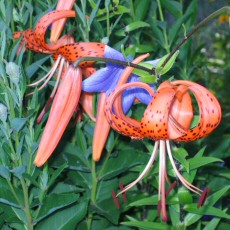
seen above with: purple Platycodon grandiflorus flowers and buds
synonym: Lilium lancifolium
with: Aconitum x bicolor 'Bicolor' (blue & white)
with: Oenothera tetragona 'Youngii' (similar to O. fruticosa)
in half-shade with: Geranium psilostemon (black-centred magenta)
Different species, different types, different bloom times - there are many choices to be found by following the links below. Additional information is available to answer your questions about nurturing these beauties.
pink Lilies
red Lilies
white Lilies
yellow Lilies
LYCHNIS
Campion, also called Catchfly, may be short-lived but their blooms over basal rosettes of foliage will delight. The flowers may be borne singly or in clusters. Some of the colours may be difficult to incorporate into gardens although the suggestions below will direct you to companion plants that will work best with their strong tones.
Lychnis: Campion, orange
where: among green-coloured plants
with: yellow and soft blue flowers such as Perovskia atriplicifolia, Rudbeckia, Achillea, Anthemis tinctoria, Delphinium
Lychnis x arkwrightii 'Vesuvius': purple foliage and orange blooms
with: Onopordum acanthium
Lychnis chalcedonica: scarlet-orange Maltese Cross
where: amid blue, white or pale yellow flowers
near: deeper red-coloured plants or bronze and purple leaves
amid: spring-flowering shrubs; white or blue flowers
with: tall Oenothera (Evening Primrose), Coreopsis, Gaillardia, Lilium (white, soft yellow or orange)
with: sky-blue Delphinium, Chrysanthemum x superbum, Papaver nudicaule, Rudbeckia, Oenothera
with: Anthemis tinctoria, Perovskia atriplicifolia, Campanula glomerata
Find other forms at the links below. Additional information is provided on each page that might give you a helping hand in growing these perennials.
pink Lychnis
red Lychnis
Lychnis with silver foliage
white Lychnis
PAPAVER
 The crepe-paper flowers of Poppies provide a dazzling effect whatever the plant's size or colour. Watch for self-sown seedlings to perpetuate the show. Surround bold coloured forms with more subtle tones to ease the impact. You can't go wrong with any of the combination suggested below.
Papaver orientale: Oriental Poppy
The crepe-paper flowers of Poppies provide a dazzling effect whatever the plant's size or colour. Watch for self-sown seedlings to perpetuate the show. Surround bold coloured forms with more subtle tones to ease the impact. You can't go wrong with any of the combination suggested below.
Papaver orientale: Oriental Poppy
beside: Helenium 'Gold Fox', Polemonium foliosissimum
Papaver orientale: scarlet-orange
with: cream Iris, lacy white Valeriana officinalis
amid: plenty of green tones
with: Iris sibirica (purple) & Hemerocallis lilioasphodelus (fragrant lemon daylily)
Papaver rupifragum: Spanish Poppy, a rockery perennial, self-seeds in the border
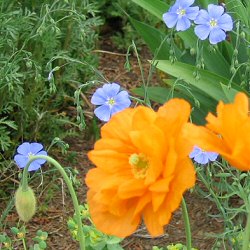
above with: blue Linum perenne
goes with: everything around it, even pink tones
orange echo with: Hemerocallis 'Tiny Pumpkin'
Papery poppies are available in many more forms as you will see if you click on the links below.
pink Poppies
red Poppies
Poppies with silver foliage
x PARDANCANDA
The Candy Lily, although similar to Blackberry Lily, Belamcanda (see above), has more varied colour choices. Blooming in mid to late summer for up to three weeks, in full sun or light shade and well-drained soil, its sword-like foliage and vibrant flower colours will add a hint of the exotic to your garden, even as far north as Zone 4. This is an inter-generic cross between Belamcanda and Pardanthopsis. Not only is this genus Iris-like but has now been reclassified and is now correctly called Iris x norissii. For more information about this reclassification, follow the link to Joe Pye Weeds Flowers and scroll down to near the bottom of the document.
x Pardancanda norrisii: Candy Lily

with: same companions as Belamcanda above
in sun with: Sporobolus heterolepsis (Prairie Drop Seed Grass, under 2')
with: Pennisetum setaceum, Echinacea purpurea, Geranium sanguineum, Perovskia atriplicifolia
with: Gypsophila paniculata, Liatris spicata, Thalictrum delavayi, Veronica, Achillea, Perovskia, Daisies
Look for these and other cultivars of this wonderful perennial in oranges as well as other colours and colour combinations.
- 'Dazzler Series': 8-10"x8-12", a dwarf seed strain
- 'LSS Dandy Candy': 8-12"x8-12"
- 'Kiba Giant': 30", variegated yellow, orange or purple
- 'Purple Stitch': 8-12"x8-12", yellow with purple bands around sepals
- 'LSS Royal Tiger': 8-12"x8-12", yellow and purple tiger pattern
- 'LSS Red Tiger': similar to 'LSS Royal Tiger', red and gold tiger pattern
- 'Sangria': 24", purple and gold flowers
- 'Sunset Tones': 12-18"x9-12", seed strain, softer more muted tones than others
- 'Yellow Hybrids':
PHLOX
  Garden favourites, the Phlox family of plants is revered for many attributes - fragrance, ease of culture, prolific bloom over a long period as well as a wealth of choices in nearly every height and colour. Whether you choose the woodland species, the mounding edgers or border varieties such as those below you will be thrilled with the results.
Phlox paniculata: Garden Phlox, orangey shades
Phlox paniculata 'Orange Perfection'
Garden favourites, the Phlox family of plants is revered for many attributes - fragrance, ease of culture, prolific bloom over a long period as well as a wealth of choices in nearly every height and colour. Whether you choose the woodland species, the mounding edgers or border varieties such as those below you will be thrilled with the results.
Phlox paniculata: Garden Phlox, orangey shades
Phlox paniculata 'Orange Perfection'
with: Phlox paniculata (purple), Salvia x superba
More wonderful Phlox choices can be found at the links below.
numerous Phlox forms
Phlox as edgers
blue Phlox
pink Phlox
red Phlox
white Phlox
Phlox for shade
RUDBECKIA
 Coneflowers certainly add vibrancy to sunny spots in our mid-summer gardens. Many are native North American wildflowers. Their daisy-shaped blooms with ray florets around a center of disk florets are easily recognizable. In addition they are generally untroubled by pests or disease and require no special fertilization or watering. Most have yellow flowers, but there is at least one in the orange range as you will see below.
Rudbeckia fulgida speciosa 'Goldsturm': Orange Coneflower
Coneflowers certainly add vibrancy to sunny spots in our mid-summer gardens. Many are native North American wildflowers. Their daisy-shaped blooms with ray florets around a center of disk florets are easily recognizable. In addition they are generally untroubled by pests or disease and require no special fertilization or watering. Most have yellow flowers, but there is at least one in the orange range as you will see below.
Rudbeckia fulgida speciosa 'Goldsturm': Orange Coneflower
called: the best of the Coneflowers, said to be among the top 10 perennials of all time
with: Monarda, especially red Monarda didyma, Chrysanthemum x superbum
beside: Sedum 'Autumn Joy', (white) Phlox paniculata
behind: (pink) Heuchera
interplanted with: Tulipa 'Orange Favorite' (a parrot type)
combined with: Perovskia x atriplicifolia & annual Salvia farinacea 'Victoria'
with: Coreopsis verticillata 'Zagreb'
mass planted with: Ornamental Grasses (Pennisetum alopecuroides) & Sedum 'Autumn Joy'
Mid-summer without the yellow tones of the Rudbeckia is impossible to imagine. Try any of the many at the link below to add some "kick" to your borders.
yellow Rudbeckia
TROLLIUS
Globeflower, a showy spring-blooming perennial, is composed, not of petals, but of petal-like sepals. Foliage is divided and lovely in itself, but it is the rounded globes of blooming colour on long stalks that give the plant its common name. Provide the moist, humus-rich soil in partial shade where it can flourish and you will be delighted with the charm of this lovely plant. Follow the link for a profile of the Trollius.
Trollis ledebouri: 2', rich orange flower, late-blooming
where: light shade with regular moisture
Information on growing Globeflower and partnership ideas are found at the link below.
yellow Trollius
TULIPA
If you only grow the white, yellow, pink or red-flowering forms of this bulb, you have a whole new experience awaiting you with any of the choices available in the orange range of colours outlined below.
Tulipa: an unnamed orange form
Tulipa greigii 'Oriental Splendour': orange/red/yellow combination
Tulipa praestans 'Fusilier': 12", orange-red
Tulipa 'Dillenburg': very late, peachy orange
Tulipa 'General de Wet': citrus-scented, soft orange etched with red
Tulipa 'Orange Emperor': soft orange
A wealth of Tulip choices with plant partners suggested by various gardening experts can be found at the links below.
a multitude of Tulips
red Tulips
white Tulips
Tulips with variegated foliage
There are more orange perennials to be added, so please come back again soon.
All of our own Gardens By The Bay pages can be accessed by clicking on the links below.
HOME
GARDEN POETRY |
GARDEN POETRY MUSE
GEORGIAN BAY VIEW
BOTANICAL LATIN - BASICS
COLOR THEORY
THE GARDENS
CORNER GARDEN CONSTRUCTION |
CORNER GARDEN PLANTING |
LONG GARDEN
EAST GARDEN |
HOSTA GARDEN |
NORTH GARDEN |
WINTER GARDENS
PLANT PARTNERSHIPS
BLUE PERENNIALS Aconitum -
Geranium |
Iris - Vinca
BULBS Allium - Hyacinthus |
Narcissus only |
Tulipa only |
Minor Bulbs
BUTTERFLY MAGNETS Anaphalis - Hemerocallis |
Liatris - Veronicastrum
 DAYLILIES Spider & Unusual Form DAYLILIES Spider & Unusual Form EDGERS Arabis - Iris |
Nepeta - Veronica
FOLIAGE PERENNIALS
Alchemilla - Tanacetum
HOSTA Hosta - all
HUMMINGBIRD-FRIENDLY PERENNIALS Alcea - Salvia
ORANGE PERENNIALS Achillea - Tulipa
ORNAMENTAL GRASSES Acorus - Imperata |
Miscanthus - Spodiopogon
PINK PERENNIALS Achillea - Lilium |
Lychnis - Veronica
PURPLE PERENNIALS Aconitum - Liatris |
Polemonium - Veronica
RED PERENNIALS Achillea - Veronica
SHADE PERENNIALS Aegopodium - Erythronium |
Ferns - Polemonium |
Polygonatum - Vinca
SILVER FOLIAGE PERENNIALS
Achillea - Cerastium
|
Cornus - Limonium
|
Lunaria - Veronica
SIMPLY SPECIAL PERENNIALS Acanthus - Saxifraga
WHITE PERENNIALS Achillea - Iris |
Kalimeris - Yucca
YELLOW PERENNIALS Achillea - Hypericum |
Inula - Verbascum
VARIEGATED-FOLIAGE PERENNIALS Acorus - Erythronium |
Hakonechloa - Lysimachia |
Miscanthus - Yucca
PLANT PROFILES
Dianthus 'Tiny Rubies' |
Geranium |
Geum coccineum |
Kerria japonica |
Knautia macedonica
Paeonia tenuifolia |
Papaver somniferum |
Rudbeckia |
Salvia 'East Friesland'
Trollius |
Veronica 'Sunny Border Blue'
PROPAGATION
DIVISION - SPRING ONLY |
DIVISION - FALL ONLY |
DIVISION - SPRING OR FALL |
DO NOT DIVIDE
FERTILIZATION
EDGERS Arabis - Iris |
Nepeta - Veronica
FOLIAGE PERENNIALS
Alchemilla - Tanacetum
HOSTA Hosta - all
HUMMINGBIRD-FRIENDLY PERENNIALS Alcea - Salvia
ORANGE PERENNIALS Achillea - Tulipa
ORNAMENTAL GRASSES Acorus - Imperata |
Miscanthus - Spodiopogon
PINK PERENNIALS Achillea - Lilium |
Lychnis - Veronica
PURPLE PERENNIALS Aconitum - Liatris |
Polemonium - Veronica
RED PERENNIALS Achillea - Veronica
SHADE PERENNIALS Aegopodium - Erythronium |
Ferns - Polemonium |
Polygonatum - Vinca
SILVER FOLIAGE PERENNIALS
Achillea - Cerastium
|
Cornus - Limonium
|
Lunaria - Veronica
SIMPLY SPECIAL PERENNIALS Acanthus - Saxifraga
WHITE PERENNIALS Achillea - Iris |
Kalimeris - Yucca
YELLOW PERENNIALS Achillea - Hypericum |
Inula - Verbascum
VARIEGATED-FOLIAGE PERENNIALS Acorus - Erythronium |
Hakonechloa - Lysimachia |
Miscanthus - Yucca
PLANT PROFILES
Dianthus 'Tiny Rubies' |
Geranium |
Geum coccineum |
Kerria japonica |
Knautia macedonica
Paeonia tenuifolia |
Papaver somniferum |
Rudbeckia |
Salvia 'East Friesland'
Trollius |
Veronica 'Sunny Border Blue'
PROPAGATION
DIVISION - SPRING ONLY |
DIVISION - FALL ONLY |
DIVISION - SPRING OR FALL |
DO NOT DIVIDE
FERTILIZATION
BULBS |
ORNAMENTAL GRASSES |
PERENNIALS |
SHRUBS |
VINES
LINKS
GARDENS |
LOCAL GARDENS |
BOTANICAL TERMINOLOGY
GARDENING BOOKS |
NON-GARDENING
HOME
|
|
|